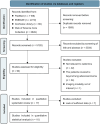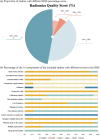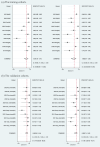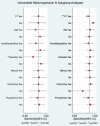Predictive value of radiomic features extracted from primary lung adenocarcinoma in forecasting thoracic lymph node metastasis: a systematic review and meta-analysis
- PMID: 38762472
- PMCID: PMC11102161
- DOI: 10.1186/s12890-024-03020-x
Predictive value of radiomic features extracted from primary lung adenocarcinoma in forecasting thoracic lymph node metastasis: a systematic review and meta-analysis
Abstract
Background: The application of radiomics in thoracic lymph node metastasis (LNM) of lung adenocarcinoma is increasing, but diagnostic performance of radiomics from primary tumor to predict LNM has not been systematically reviewed. Therefore, this study sought to provide a general overview regarding the methodological quality and diagnostic performance of using radiomic approaches to predict the likelihood of LNM in lung adenocarcinoma.
Methods: Studies were gathered from literature databases such as PubMed, Embase, the Web of Science Core Collection, and the Cochrane library. The Radiomic Quality Score (RQS) and the Quality Assessment of Diagnostic Accuracy Studies-2 (QUADAS-2) were both used to assess the quality of each study. The pooled sensitivity, specificity, and area under the curve (AUC) of the best radiomics models in the training and validation cohorts were calculated. Subgroup and meta-regression analyses were also conducted.
Results: Seventeen studies with 159 to 1202 patients each were enrolled between the years of 2018 to 2022, of which ten studies had sufficient data for the quantitative evaluation. The percentage of RQS was between 11.1% and 44.4% and most of the studies were considered to have a low risk of bias and few applicability concerns in QUADAS-2. Pyradiomics and logistic regression analysis were the most commonly used software and methods for radiomics feature extraction and selection, respectively. In addition, the best prediction models in seventeen studies were mainly based on radiomics features combined with non-radiomics features (semantic features and/or clinical features). The pooled sensitivity, specificity, and AUC of the training cohorts were 0.84 (95% confidence interval (CI) [0.73-0.91]), 0.88 (95% CI [0.81-0.93]), and 0.93(95% CI [0.90-0.95]), respectively. For the validation cohorts, the pooled sensitivity, specificity, and AUC were 0.89 (95% CI [0.82-0.94]), 0.86 (95% CI [0.74-0.93]) and 0.94 (95% CI [0.91-0.96]), respectively.
Conclusions: Radiomic features based on the primary tumor have the potential to predict preoperative LNM of lung adenocarcinoma. However, radiomics workflow needs to be standardized to better promote the applicability of radiomics.
Trial registration: CRD42022375712.
Keywords: Adenocarcinoma of Lung; Lymphatic Metastasis; Machine learning; Positron Emission Tomography Computed Tomography; Tomography, X-Ray Computed.
© 2024. The Author(s).
Conflict of interest statement
The authors declare no competing interests.
Figures






References
-
- Shimada Y, Tsuboi M, Saji H, Miyajima K, Usuda J, Uchida O, et al. The prognostic impact of main bronchial lymph node involvement in non-small cell lung carcinoma: suggestions for a modification of the staging system. Ann Thorac Surg. 2009;88(5):1583–1588. doi: 10.1016/j.athoracsur.2009.04.065. - DOI - PubMed
Publication types
MeSH terms
Grants and funding
- 2022JKJNTZ19/Research Project of Zhejiang Chinese Medical University
- 2022FSYYZY08/Research Project of Zhejiang Chinese Medical University
- 2022C03046/"Pioneer" and "Leading Goose" R&D Program of Zhejiang
- LTGY23H180001/Zhejiang Provincial Natural Science Foundation of China
- 82102128/National Natural Science Foundation of China
LinkOut - more resources
Full Text Sources
Medical

